“On the occasion of World Food Week and World Food Day 2009, let us reflect on those numbers and the human suffering behind them. Crisis or no crisis, we have the know-how to do something about hunger. We also have the ability to find money to solve problems when we consider them important. Let us work together to make sure hunger is recognized as a critical problem, and solve it.”
– Food and Agriculture Organization of the United Nations
I don’t know if it’s something that my generation, or those just entering parenting age, still use to get their kids to eat, but I grew up with the constant admonition to “eat your dinner because there are people starving in ___”. The location changed regularly, sometimes Europe, sometimes the Middle East, Bangladesh popped up for awhile there – it was irrelevant – from the kids’ side view, how, exactly, did finishing what was on the plate help those who had nothing on their plates half a world away? Oh, there were the arguments for “not wasting food”, which ostensibly could have had a connection, though our response was, sottovoce, “can’t we just send it to them?”
This musing all came about as I planned out our weekend’s menu around World Food Day 2009, Acheiving food security in times of crisis, the theme for this year’s annual summit. Of course, it was a given that pretty much the whole planet’s worth of cuisines were up for grabs – in the end, however, in a round about way, I started with the regularly updated Human Development Index, a rating of a combination of factors that include everything from hunger to education and literacy, to birth and death rates – and from each of the major areas of the globe that have countries that fell into the lowest levels of the index, I picked out the country that, at that moment, was rated the lowest – Nepal in Asia, Niger in Africa, Guatemala in the Americas, Papua-New Guinea in the South Pacific, and Moldova in Europe. I looked for classic “national dishes”, and then, took off from there to design a menu inspired by each of those. Not, we must admit, what the folks in those countries were likely eating this last weekend, but perhaps it comes down to recognizing and appreciating food and food security when you have it, because you never know where life will find you.
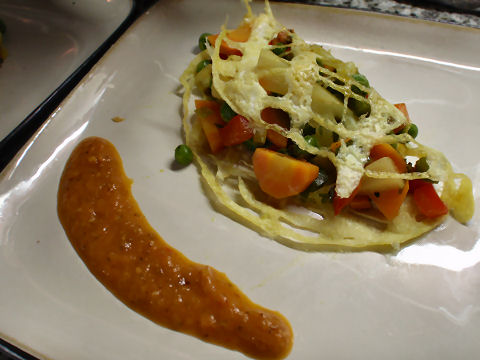
If you’ve never had momo, you’ve never had one of the world’s greatest steamed dumplings. In Nepal, they are an art form, even in the poorest of communities, and the intricate and intense spicing is something that one cook or another achieves local fame for. One of the most popular forms are vegetable filled, not suprising given the Buddhist bent of a large portion of the population. I opened up the dumpling, so to speak, and made a stir-fry of cauliflower, carrots, peas, corn, red and green bell peppers, chilies and green onions, all in a bit of oil that was spiked with a mix of szechuan pepper, ginger, turmeric, salt, black pepper and fenugreek. Then I finished it with a mix of chopped mint, parsley and cilantro. For presentation I decided to return to the “egg nets“, and then served the whole thing up with a tomato achaar, a classic sauce of the region made from roasted tomatoes, chilies, garlic and ginger blended with toasted cumin, coriander and mustard seeds, szechuan peppercorns, salt and pepper.
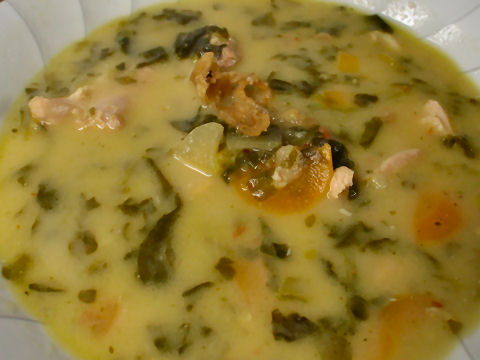
Moving to western Africa, our soup course, and one of my favorites from the traditional cuisine, a peanut soup – since I was asked for a detailed recipe, I’ve edited this to include that – keeping in mind that that’s now how I cook and your results may be different – I just eyeball/estimate stuff for the most part, and adjust things to taste.
Absolutely delicious!
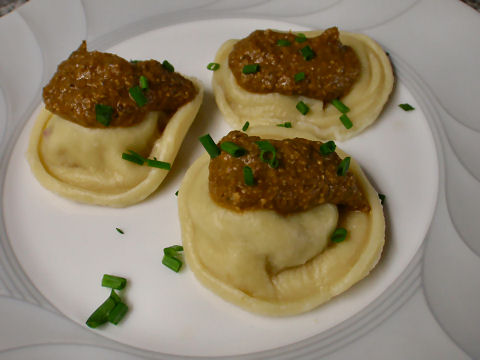
Probably the most emblematic sauce, if not one dish in particular, of Guatemala is the pepian. One of the classic ways to serve it, especially for those who can’t afford to ladle it over one or another meats, is over fried or baked green plantains. I turned this into a pasta course, boiling up the green plantains with a bit of fondor in it (Brazlian seasoned salt), then pureeing them along with some fresh goat’s milk cheese, a little sauteed bacon, salt and white pepper. When cooled, I packed the filling into pansôti, let them sit to firm up, and then boiled them up. The sauce, a mix of toasted black sesame and green pumpkin seeds, cinnamon, pasilla and chipotle peppers, cloves, cumin, black pepper, allspice and salt, and then finished with a bit of peanut oil, dark chocolate and grapefruit juice – achiote seeds would normally be part of the mix too, and I know I have some around here because someone brought them to me not all that long ago, I just couldn’t find them.
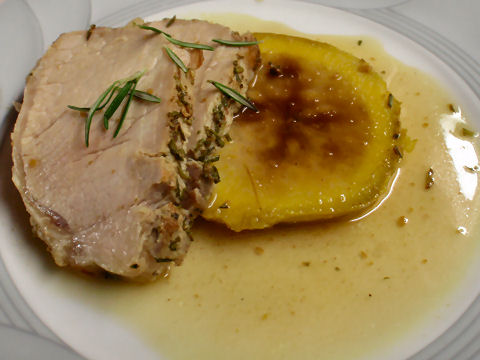
Heading off to the South Pacific and Papua-New Guinea and a traditional roast pig with sweet potatoes. It was a simple leap from there to a roast pork loin, though perhaps the dry marinade/crust of chopped rosemary and crushed black, white, green and pink peppercorns is a bit less common on the islands of that country – and it wasn’t slow roasted over a firepit for the day, simply seared and oven roasted to medium. Boiled sweet potatoes on the side, and a sauce made from a reduction of 1 bottle of sparkling cider, ¼ cup cider vinegar, 1 cup apple juice, 2 tablespoons each of brown mustard, white and brown sugar and butter, all reduced to about 1½ cups of liquid, then salt and pepper to taste.
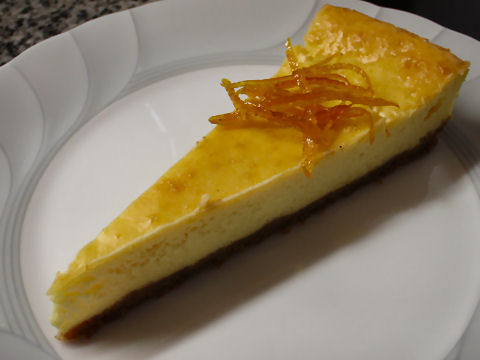
Polenta cake with orange is a popular dessert in the country of Moldova, nestled away between the Ukraine and Romania, and I simple turned it into one of our popular cheesecakes – substituting in for about half the milk that goes into the cheesecake was freshly squeezed orange juice, and instead of the small amount of flour I usually add for body, I added about ¾ cup of soft polenta, then blended it all at high speed to get the graininess out. It gives a very interesting texture to the cheesecake, much lighter than normal, and quite good. A bit of caramelized orange peel atop and a fine end to our World Food Day dinner.
What decadence! What do poor people in Argentina eat?
If that’s a real question, rather than a bit of a dig at our inspired feast, the answer is, it depends where they live. Argentina is far too large to have one style of cuisine – in the north, the food is quite similar to that of Peru and Bolivia, and much of the diet is based on corn and potatoes, with a bit of meat – variable depending on what’s available. In the center of the country, meat, beef in particular, tends to be king, and it isn’t that expensive by comparison to other ingredients, much of the diet is very beef-heavy supplemented by potatoes, and in the south, there’s wild game, fish, fruits and vegetables. Argentina, just as a point, doesn’t come close to the poverty level of the countries we’re talking about.
I guess it’s a bit of both. We recently had a go at eating at the level you might expect if you were on Govt “benefits” (welfare) in the UK. Not easy – the casualties are fresh fruit and veg…and you may begin to wish that you hadn’t developed a palate for wine!
Give it a try and see what you think,
Wembley
Wembley – it isn’t as if we haven’t had our own experiences with this, and my partner in particular, who grew up in an environment that would make your UK govt benefits look luxurious. But to suggest that one need to live in poverty simply because other people do, and not enjoy food, wine, or living when you are able, is pretty ridiculous. If you stop to look at what we actually ate, while it may have been gussied up on the plate to look pretty, there was nothing particularly decadent about it – it was simple fare – all of the recipes, while adapted for local ingredients and probably more carefully seasoned and prepared, are dishes, even if in altered form, that are part of the poverty level diets in the five countries mentioned.
[…] have made peanut soups before, in West African, Bolivian, and Thai guises. I have even once, before, more than six years before, made a quinua and […]